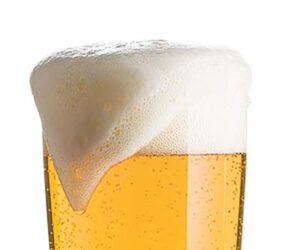Dunkelweizen
OG = 1.040 to 1.056; FG = 1.010 to 1.014; IBU = 10 to 20; SRM = 10 to 23
Bavarian dunkelweizen is a spicy, malty wheat-based ale that gets its
color from high-kilned barley malts and its character from wheat malt
and distinctive yeast. More complex and full-flavored than a Bavarian
weizen, this beer is indeed liquid bread.
In Germany, during the late 1500’s, a law was passed prohibiting
the use of wheat in brewing because more wheat was being used to make
beer than bread. This restriction only applied to the lower classes;
the clergy and nobility were still allowed to brew wheat beers. In the
late eighteenth and early nineteenth century the nobility relaxed its
rules and permitted the public to brew wheat beer.
Our recipe for a dunkelweizen is our clone of Hacker-Pschorr Weisse
Dark by Hacker-Pschorr Brewery in Munich. This hazy, copper-colored
beer has a long-lasting, off-white creamy head. It is earthy, rich and
malty with a wheat-laced aroma. Lush, smooth malt fills your mouth and
quenches your thirst with a slightly nutty nuance, while the soft,
malty finish leaves you wanting more. This beer tastes best when it’s
young so plan to drink it as soon as it’s carbonated.
Commercial Beers to Try:
Many brewers make an excellent dunkelweizen. Some of the leading
brands are Mönschshof Kapuziner Schwarze Hefeweizen, Franziskaner
Dunkel Hefe-Weissbier, HB (Hofbräuhaus Royal Court Brewery) and
Herrnbrau Hefe-Weissbier Dunkel. The breweries of Schneider, Paulaner,
Augustiner, Ayinger, Spaten and Tucher also brew great examples.
The aroma should be of malt supported by fruit — most likely
banana — and spicy clove aromas. The color ranges from light amber to
light brown. The head should be thick, creamy and long-lasting. Because
of the high volume of wheat, an unfiltered beer will be cloudy. There
should be no hop flavor or aroma and the hop bitterness should be low.
The wheat flavor should be apparent along with the caramel character of
darker roasted malts, such as Munich and Vienna. This beer can also
have a spicy, fruity flavor.
Hops, Malt and Yeast:
The hops used are typically from the Hallertau region: Spalt,
Hersbrucker or Mittelfrüh.You can substitute Saaz, Tettnanger or Perle.
At least 50 percent of the grist should comprise wheat malt with
Munich or Vienna added for color, mouthfeel and depth of flavor. A bit
of chocolate malt (not more than 1 ounce per five-gallon batch) can be
added for additional color.
The best yeast choices are Wyeast 3638 (Bavarian Weizen) for a
slightly sweeter dunkel or Wyeast 3068 (Weihenstephan) for more clove,
apple and banana notes. You can also use White Labs WLP300 (Hefeweizen
Ale). Prepare a yeast starter and aerate the wort vigorously. Wheat
yeasts will ferment very sluggishly below 65° F, so be sure to keep the
temperature at approximately 68° F.
Serving Suggestions:
Serve dunkelwiezen in a traditional wheat beer glass at 48° F
(9° C) with a grilled bratwurst sandwich piled high with caramelized onions, sauerkraut and a spicy German mustard.
—————————————————
Hacker Pschorr Weisse Dark Clone
5 gallons; OG = 1.055 to 1.056; FG = 1.011 to 1.012; IBU = 13
Ingredients
- 8 oz. German Munich malt
- 7 oz. Belgian cara-Munich malt
- 1 oz. British chocolate malt
- 6.25 lbs. Muntons wheat dry malt extract (DME)
- 4 AAUs Tettnanger bittering hops (1 oz. at 4% alpha acid)
- 1 pt. starter of Wyeast 3068 (Weihenstephan Weizen)
- 1-1/4 cups Muntons wheat dry malt extract for priming
Step by Step
Bring one gallon of water to 155° F, add crushed grain and hold for
30 minutes at 150° F. Strain the grain into the brewpot and sparge with
one gallon of 170° F water. Add the dry malt and bittering hops. Bring
the total volume in the brewpot to 2.5 gallons. Boil for 60 minutes
then remove pot from stove.
Cool wort for 15 minutes in an ice bath or chill with wort chiller.
Strain into the primary fermenter and add water to obtain 5-1/8
gallons. Add yeast when wort has cooled to below 80° F.
Oxygenate-aerate well. Ferment at 68° F for 7 days. Rack into secondary
(glass carboy). Ferment until target gravity has been reached and beer
has cleared (approximately 3 weeks). Prime and bottle. Carbonate at 70°
to 72° F for 2 to 3 weeks. Store at cellar temperature.
Partial-Mash Option:
Mash 1.25 lb. German two-row pilsner malt, 1 lb. German wheat malt, 4 oz. rice hulls or oat hulls and the specialty grains in 1 gallon water at 150° F for 90 minutes. Sparge with 2 gallons water at 168° F. Then follow the extract recipe, omitting 1.75 lb. of Muntons wheat dry malt extract from the boil.
All-Grain Option:
Mash 4 lb. German two-row pilsner malt, 5.67 lb. German wheat malt, 8 oz. rice hulls or oat hulls and the specialty grains in 3 gallons of water at 149° F for 90 minutes. Then sparge with
5 gallons of water at 168° F. The total boil time is approximately 90 minutes. Add 1 oz. of Tettnanger (bittering hop) for the last 60 minutes of the boil.


